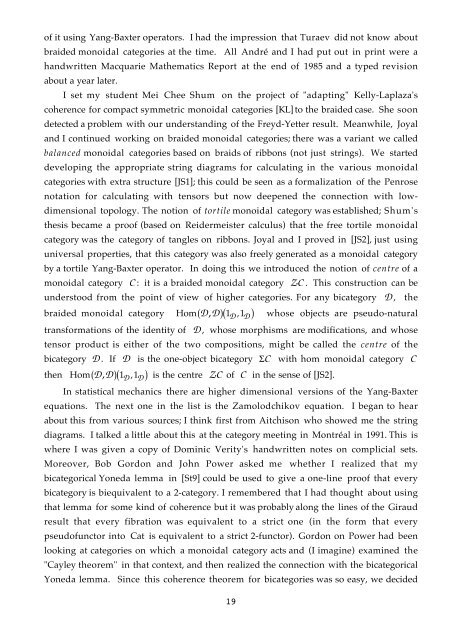An Australian conspectus of higher categories - Macquarie University
An Australian conspectus of higher categories - Macquarie University
An Australian conspectus of higher categories - Macquarie University
Create successful ePaper yourself
Turn your PDF publications into a flip-book with our unique Google optimized e-Paper software.
<strong>of</strong> it using Yang-Baxter operators. I had the impression that Turaev did not know about<br />
braided monoidal <strong>categories</strong> at the time. All <strong>An</strong>dré and I had put out in print were a<br />
handwritten <strong>Macquarie</strong> Mathematics Report at the end <strong>of</strong> 1985 and a typed revision<br />
about a year later.<br />
I set my student Mei Chee Shum on the project <strong>of</strong> "adapting" Kelly-Laplaza's<br />
coherence for compact symmetric monoidal <strong>categories</strong> [KL] to the braided case. She soon<br />
detected a problem with our understanding <strong>of</strong> the Freyd-Yetter result. Meanwhile, Joyal<br />
and I continued working on braided monoidal <strong>categories</strong>; there was a variant we called<br />
balanced monoidal <strong>categories</strong> based on braids <strong>of</strong> ribbons (not just strings). We started<br />
developing the appropriate string diagrams for calculating in the various monoidal<br />
<strong>categories</strong> with extra structure [JS1]; this could be seen as a formalization <strong>of</strong> the Penrose<br />
notation for calculating with tensors but now deepened the connection with lowdimensional<br />
topology. The notion <strong>of</strong> tortile monoidal category was established; Shum's<br />
thesis became a pro<strong>of</strong> (based on Reidermeister calculus) that the free tortile monoidal<br />
category was the category <strong>of</strong> tangles on ribbons. Joyal and I proved in [JS2], just using<br />
universal properties, that this category was also freely generated as a monoidal category<br />
by a tortile Yang-Baxter operator. In doing this we introduced the notion <strong>of</strong> centre <strong>of</strong> a<br />
monoidal category C : it is a braided monoidal category ZC . This construction can be<br />
understood from the point <strong>of</strong> view <strong>of</strong> <strong>higher</strong> <strong>categories</strong>. For any bicategory D , the<br />
( )( )<br />
braided monoidal category Hom DD , 1D, 1D whose objects are pseudo-natural<br />
transformations <strong>of</strong> the identity <strong>of</strong> D , whose morphisms are modifications, and whose<br />
tensor product is either <strong>of</strong> the two compositions, might be called the centre <strong>of</strong> the<br />
bicategory D . If D is the one-object bicategory SC with hom monoidal category C<br />
( )( )<br />
then Hom DD , 1D, 1D is the centre ZC <strong>of</strong> C in the sense <strong>of</strong> [JS2].<br />
In statistical mechanics there are <strong>higher</strong> dimensional versions <strong>of</strong> the Yang-Baxter<br />
equations. The next one in the list is the Zamolodchikov equation. I began to hear<br />
about this from various sources; I think first from Aitchison who showed me the string<br />
diagrams. I talked a little about this at the category meeting in Montréal in 1991. This is<br />
where I was given a copy <strong>of</strong> Dominic Verity's handwritten notes on complicial sets.<br />
Moreover, Bob Gordon and John Power asked me whether I realized that my<br />
bicategorical Yoneda lemma in [St9] could be used to give a one-line pro<strong>of</strong> that every<br />
bicategory is biequivalent to a 2-category. I remembered that I had thought about using<br />
that lemma for some kind <strong>of</strong> coherence but it was probably along the lines <strong>of</strong> the Giraud<br />
result that every fibration was equivalent to a strict one (in the form that every<br />
pseud<strong>of</strong>unctor into Cat is equivalent to a strict 2-functor). Gordon on Power had been<br />
looking at <strong>categories</strong> on which a monoidal category acts and (I imagine) examined the<br />
"Cayley theorem" in that context, and then realized the connection with the bicategorical<br />
Yoneda lemma. Since this coherence theorem for bi<strong>categories</strong> was so easy, we decided<br />
19
















